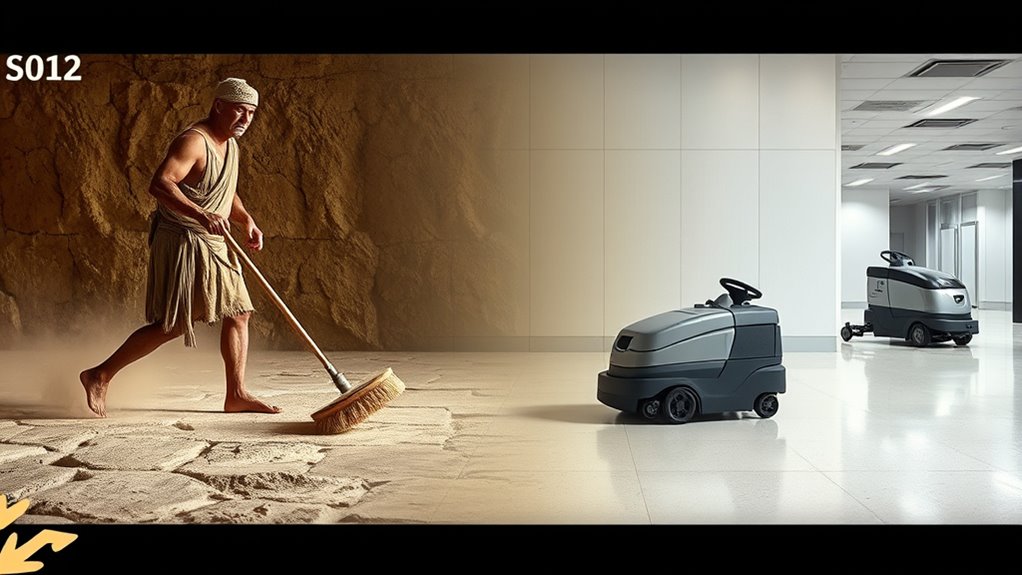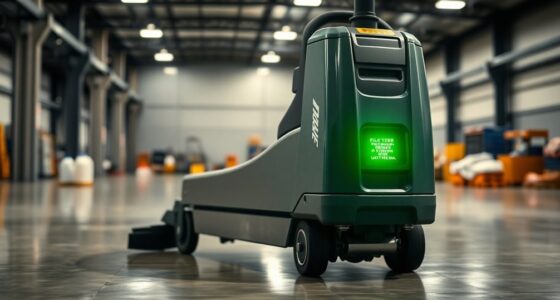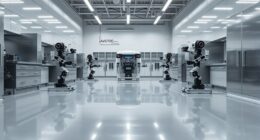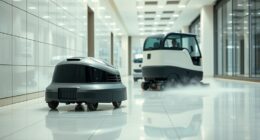From the Bronze Age, humans relied on basic manual tools like brooms, cloths, and water to clean floors. Over time, innovations like wooden scrapers and rudimentary mops improved efficiency. The Industrial Revolution introduced steam-powered devices and early mechanical scrubbers, marking a major shift. Today, advanced automated systems use batteries, sensors, and AI for faster, smarter cleaning. If you keep exploring, you’ll discover how each step shaped the future of floor scrubbing technology.
Key Takeaways
- Early floors were cleaned manually with simple tools like brooms and water, focusing on basic hygiene.
- Civilizations introduced wooden scrapers and rudimentary mops, improving cleaning efficiency over time.
- The Industrial Revolution brought steam-powered scrubbers, marking a shift toward mechanized cleaning methods.
- Modern technology features battery-powered robotic scrubbers with sensors, enhancing speed and automation.
- Future innovations include AI-driven systems emphasizing sustainability, energy efficiency, and smarter cleaning solutions.

The history of floor scrubbing technology reveals a fascinating evolution from manual labor to sophisticated automation. In ancient times, cleaning floors was a labor-intensive task, often involving simple tools like brooms, cloths, and water. People recognized the importance of maintaining hygiene, but their methods were rudimentary. Ancient cleaning practices relied heavily on physical effort, with individuals using scrub brushes, cloths, and water to remove dirt and grime from stone, wood, and earthen floors. These early techniques laid the foundation for what would become a continuous pursuit of more efficient cleaning methods.
From manual tools to modern automation, the evolution of floor scrubbing reflects ongoing innovation in hygiene and efficiency.
As civilizations advanced, so did their approaches to floor cleaning. The development of more effective tools, such as wooden scrapers and rudimentary mops, marked a shift toward better efficiency. The Industrial Revolution brought significant progress, introducing innovations like steam-powered devices and early mechanical scrubbers. These inventions reduced human effort and increased the speed of cleaning, showcasing the first signs of modern innovations. Automated floor scrubbers appeared in the early 20th century, initially as bulky machines used in industrial settings, but their design and functionality rapidly improved. This era marked a milestone from purely manual methods to mechanized solutions, driven by the need for cleaner environments in factories, hospitals, and public spaces.
Fast forward to today, and you’re now witnessing a landscape dominated by advanced technology. Modern innovations have transformed floor scrubbing into a highly efficient, often automated process. Battery-powered scrubbers, robotic vacuum-scrubbers, and AI-driven cleaning systems now handle large areas with minimal human intervention. These machines incorporate sensors to navigate complex environments, ensuring thorough cleaning while optimizing energy use. The change from manual labor to lithium-ion batteries has made these devices lighter, more powerful, and longer-lasting. This technological leap allows for continuous, reliable operation, making cleaning faster and less labor-intensive than ever before. Additionally, the integration of advanced battery technology has greatly enhanced the performance and portability of these cleaning devices.
The journey from ancient cleaning methods to today’s cutting-edge solutions highlights an ongoing quest for efficiency and hygiene. You benefit from centuries of innovation that have drastically reduced physical effort while increasing effectiveness. Modern innovations continue to push the boundaries, integrating smart technology and sustainable practices into floor scrubbing. This evolution demonstrates how human ingenuity and technological progress constantly improve daily tasks, transforming a once manual chore into a streamlined, automated process. As you see, the history of floor scrubbing tech is a testament to how far we’ve come—and a glimpse into what the future may hold.
Frequently Asked Questions
What Are the Environmental Impacts of Modern Floor Scrubbing Chemicals?
Modern floor scrubbing chemicals can impact the environment through the use of non-biodegradable formulas that persist in ecosystems. You might unwittingly leave toxic residue behind, which can harm wildlife and contaminate water sources. Choosing biodegradable formulas helps reduce these risks, ensuring that the chemicals break down naturally and don’t contribute to pollution. By being mindful, you can help protect the environment while maintaining clean floors.
How Do AI and Robotics Influence Current Floor Cleaning Technologies?
You might think AI and robotics are just futuristic ideas, but they revolutionize floor cleaning today. With robotic automation, you get consistent, thorough cleaning without manual effort. AI efficiency allows these machines to adapt to different surfaces and optimize their routes, saving time and resources. This technology not only boosts cleanliness but also reduces environmental impact by minimizing chemical use and energy consumption, making your cleaning smarter and greener.
What Are the Future Trends in Sustainable Floor Scrubbing Solutions?
When exploring future trends in sustainable floor scrubbing solutions, you’ll notice a shift towards biodegradable solutions that minimize environmental impact. You’ll also see a rise in energy-efficient devices designed to reduce power consumption while maintaining cleaning effectiveness. These innovations help you contribute to sustainability efforts, making your cleaning routines more eco-friendly. Expect smarter, greener technology to become the standard, supporting both your needs and the planet’s health.
How Do Different Flooring Materials Affect Cleaning Technology Choices?
Imagine your floor as a battlefield, each material demanding a unique weapon. Your cleaning device must adapt like a chameleon, matching the floor material compatibility to conquer dirt without damage. Tile, hardwood, or carpet—each needs tailored solutions. You must choose wisely, ensuring your cleaning tech adjusts seamlessly, preserving the floor’s integrity while delivering spotless results. The right match turns cleaning from a chore into a triumphant victory.
What Are the Health and Safety Considerations for Commercial Floor Scrubbing?
When using commercial floor scrubbing equipment, you need to consider health and safety. Watch out for slip hazards caused by wet floors, and ensure proper signage is in place. Protect yourself from chemical exposure by wearing gloves and masks, especially when handling cleaning solutions. Regular training helps you recognize risks and follow safety protocols, reducing accidents and ensuring a safer environment for everyone.
Conclusion
From ancient brushes to modern lithium-powered machines, floor scrubbing tech has evolved remarkably. Yet, despite the advanced gadgets, the goal remains the same: clean, sparkling floors. As you see the progress from rough stone tools to sleek, silent devices, remember that innovation often balances tradition with modernity. In this dance between old and new, the pursuit of cleanliness continues—proving that no matter the era, a shining floor is still worth the effort.









